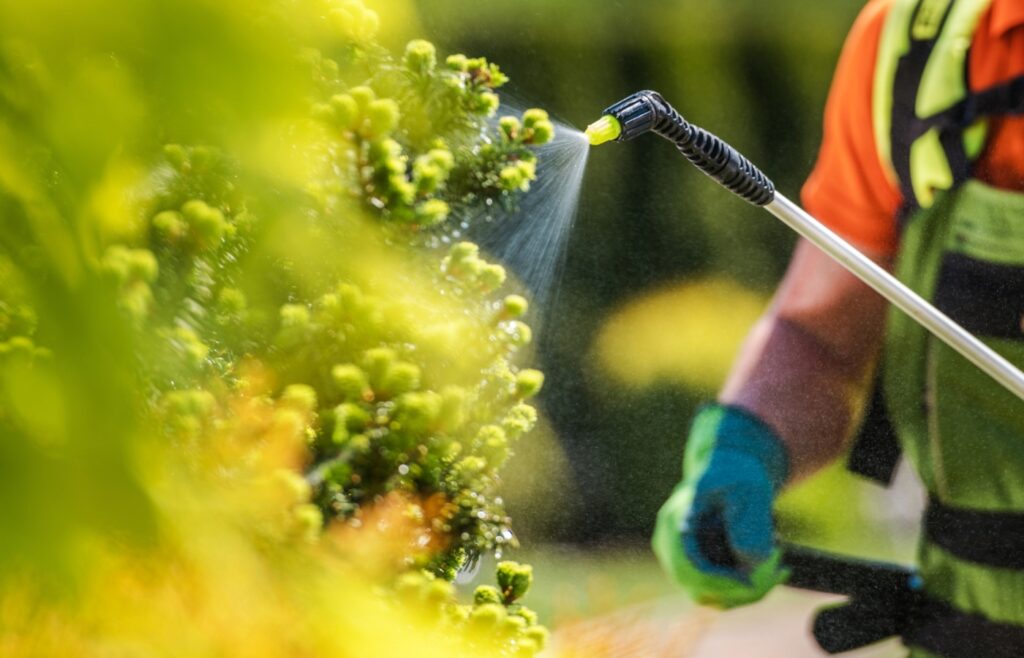
Winter rain is good for our gardens and lawns, but it’s also good for those pesky weeds. As soon as the weather warms up and the days get longer, weed seeds germinate with a vengeance. This would not be so bad, but the unwanted plants always outgrow the desirable plants. Pulling weeds is hard work, so many weary gardeners end up using herbicides to make the job easier. If you are tempted to reach for that bottle, make sure you follow the directions on the label and are aware of the potential damage that herbicides (and other chemicals) can do to your garden.
Plants can be damaged by other chemicals as well. Air pollution damages roadside plantings and sensitive plants located in areas with poor air quality. Excess salinity (salt), alkalinity or acidity, nutrient deficiencies, and water stress can produce symptoms that mimic herbicide toxicity. Viruses, nematodes, and microbial leaf spot diseases are some biological causes of this type of damage. If you suspect herbicides, make sure you rule out these causes first, since most of them are easily remedied.
What does herbicide damage look like? Toxicity from pre-emergent herbicides, like those applied to lawns to prevent weed seed germination, will often appear in older leaves. Look for chlorosis, or leaf yellowing, brown or yellow spots, blotchy or bleaching in leaf veins that spreads to the whole leaf, and subsequent leaf drop. Pre-emergent herbicides are designed to target germinating seeds and young seedlings, so these will likely die if exposed. Pre-emergent herbicides, unfortunately, remain active in the soil for a long time. For this reason, use with extreme caution and follow application directions closely. Avoid applying in areas where roots from desirable plants are likely to grow (along a fence line or border, for instance).
Toxicity from post-emergent herbicides can cause twisted or malformed leaves and young shoots, stunting, and bleaching or chlorotic leaves.
Broadleaf herbicides are often used against weeds in lawns. They are supposed to kill broadleaf weeds while leaving grass unharmed. The herbicide is absorbed through the roots and soon travels throughout the entire plant. If it is overapplied, it can spread to nearby shrubs and other landscape plants and cause damage. Dicamba can cause damage this way, even in very low concentrations, so it’s vitally important to follow directions to avoid overapplication.
Related Articles
Finding inspiration for pollinator-friendly home gardens at The Living Desert
The joys of a semi-dwarf navel orange tree and other hardy citrus with winter fruit
In sodden California, few homeowners have flood insurance
What’s wrong with your compost pile? Let’s explore the possibilities
Asparagus, now and some thoughts on bags in the garden
Broad-spectrum or nonselective herbicides, such as glyphosate, glufosinate, and pelargonic acid, are absorbed during photosynthesis. For this reason, they should be applied during the growing season. Plants exposed to nonselective herbicides during the winter months will not show any symptoms until spring, when they start growing again. Yellowing or bleaching, stunting, and distortion in new leaves will occur.
Herbicides should only be applied in doses indicated on the label. Never apply on windy days and avoid irrigating after application. If using a sprayer, label it for herbicide use only since the residue is very difficult to wash off.
Better yet, get a narrow trowel or weeder and hand weed. For me, it’s satisfying to pull a big weed out by the tap root. Those flame-thrower weeders look like fun, but I don’t recommend them for California since we don’t want the state to catch fire yet again.
Los Angeles County
[email protected]; 626-586-1988; http://celosangeles.ucanr.edu/UC_Master_Gardener_Program/
Orange County
[email protected]; 949-809-9760; http://mgorange.ucanr.edu/
Riverside County
[email protected]; 951-683-6491 ext. 231; https://ucanr.edu/sites/RiversideMG/
San Bernardino County
[email protected]; 909-387-2182; http://mgsb.ucanr.edu/
